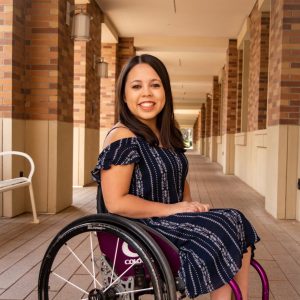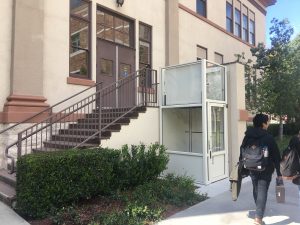
Jason McAlexander’s office is perched across Glassell Street from Chapman University’s bustling student life. Despite his view of the vast amount of students hanging around campus, he sees no one in a wheelchair– because there is no one.
At least it’s rare to see one.
As Director of Disabilities Services at Chapman University, and a wheelchair user himself, this is a topic of concern. Chapman University is in full compliance with the Americans with Disabilities Act since the renovations to Smith Hall were recently completed. However, being able to enter into buildings doesn’t mean that the problem of navigating campus life has been solved for people with disabilities.

Just ask junior Abbey Umali, who uses a wheelchair to navigate her ambitious schedule. She recalls multiple occasions where elevators malfunctioned, causing her to be over twenty minutes late to class. In another instance, a broken elevator kept her from eating at the Randall Dining Commons for two weeks. The lack of elevators in the Davis Apartment Complex where she lives creates a barrier between her and the Residence Life Office on the second floor.
Despite these issues, compared to many other universities, Chapman still has a big advantage: it’s flat.
“I chose to go to Chapman because it’s relatively flat compared to a lot of the schools I applied to,” Umali said.
McAlexander understands that but also acknowledges the hurdles that are faced when trying to create an inclusive space for people with disabilities due to the range of needs individuals require. Even within the small category of wheelchair users, there is a wide spectrum of needs to consider in order to make a resource accessible to all, and unfortunately, someone is almost always left out.
“Accessibility doesn’t necessarily mean user friendly,” he said.
Art Blaser, a peace studies and political science professor at Chapman for nearly 40 years, uses a joystick to steer his wheelchair. The lack of automatic doors around campus prevent him from easily accessing several locations, such as classrooms and restrooms
To combat this challenge, the university’s Disability Services Office can accommodate people with disabilities by moving classes to different floors or buildings, decreasing travel time and effort for students and professors with limited mobility.
McAlexander would like to see the campus move towards a direction that houses all of the student resources in a single building on main campus, including disability services, health center visits, and tutoring. The resource offices located on Glassell across from main campus are accessible to individuals in wheelchairs, but only after a 15-minute roll down the street to reach them.
But, without making a single change to the physical structure of the campus, inclusivity can still be made more attainable.
As far as the law reaches, there isn’t much left the university can do to provide more accessible resources around campus. They’ve pretty much maxed out their footprint in terms of where they can build, and renovations come with a hefty price tag. But according to McAlexander, the issue extends past the code and into recognition of the disabled community and their needs.

“The disabled community is far behind. We’re not talked about in TV or movies, ” McAlexander says.
Both Umali and Blaser stressed similar statements. When asked how to make the campus a better place, neither one of them mentioned that of new buildings or renovations but rather more disabled students on campus.
By curating a welcoming environment, more students with disabilities will flock to the university, according to McAlexander.
More than anything, there is a desire for dialogue and normalization of disabilities according to McAlexander, Umali and Blaser. When the disabled community is in people’s thoughts, the resources and accommodations are more likely to be provided, giving students a sense of community within the university.
Now, the question is: how far is the university willing to go beyond just satisfying code?
